Abstract
1. Using 24Na to label the exchangeable sodium in the tissue and either [35S]sulphate or [14C]sucrose to label the extracellular spaces, the intracellular sodium concentration of frog heart ventricles was determined and found to be between about 5 and 10 m-mole/kg cell water.
2. The intracellular potassium concentration, obtained by flame-photometric analysis, was approximately 163 m-mole/kg cell water.
3. Two different methods were employed to study the sodium tracer efflux of resting heart ventricles. One involved a double-tracer technique, using 24Na to indicate the release of the exchangeable tissue sodium, and 35SO4 to indicate, approximately, the release of extra-myocardial sodium. In the other a comparison was made of the sodium release from the tissue when it contained sodium either at the normal concentration or at a concentration enhanced by exchange with intracellular potassium.
4. The magnitude of the sodium efflux from heart fibres as measured by both methods was of the order 50-100 p-mole/cm2 sec. Simultaneously with this cellular efflux a substantial amount of sodium was released from extra-myocardial spaces and tissues.
5. The net efflux of potassium ions from heart cells that occurred when heart ventricles were perfused with potassium-depleted fluids was determined. The results were used to obtain an indirect estimate, of about 2-3 p-mole/cm2 sec, for the resting sodium influx.
6. The significance of these different values of sodium efflux and influx is discussed.
Full text
PDF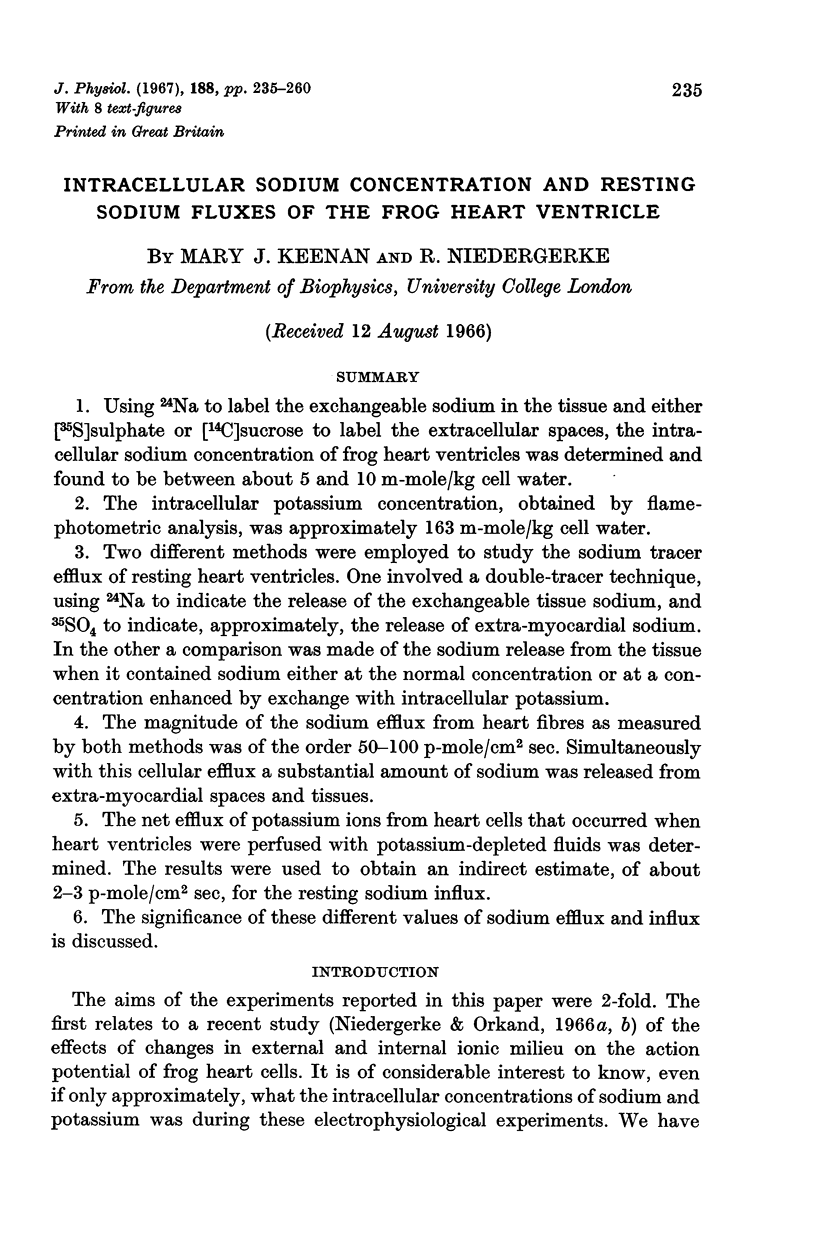
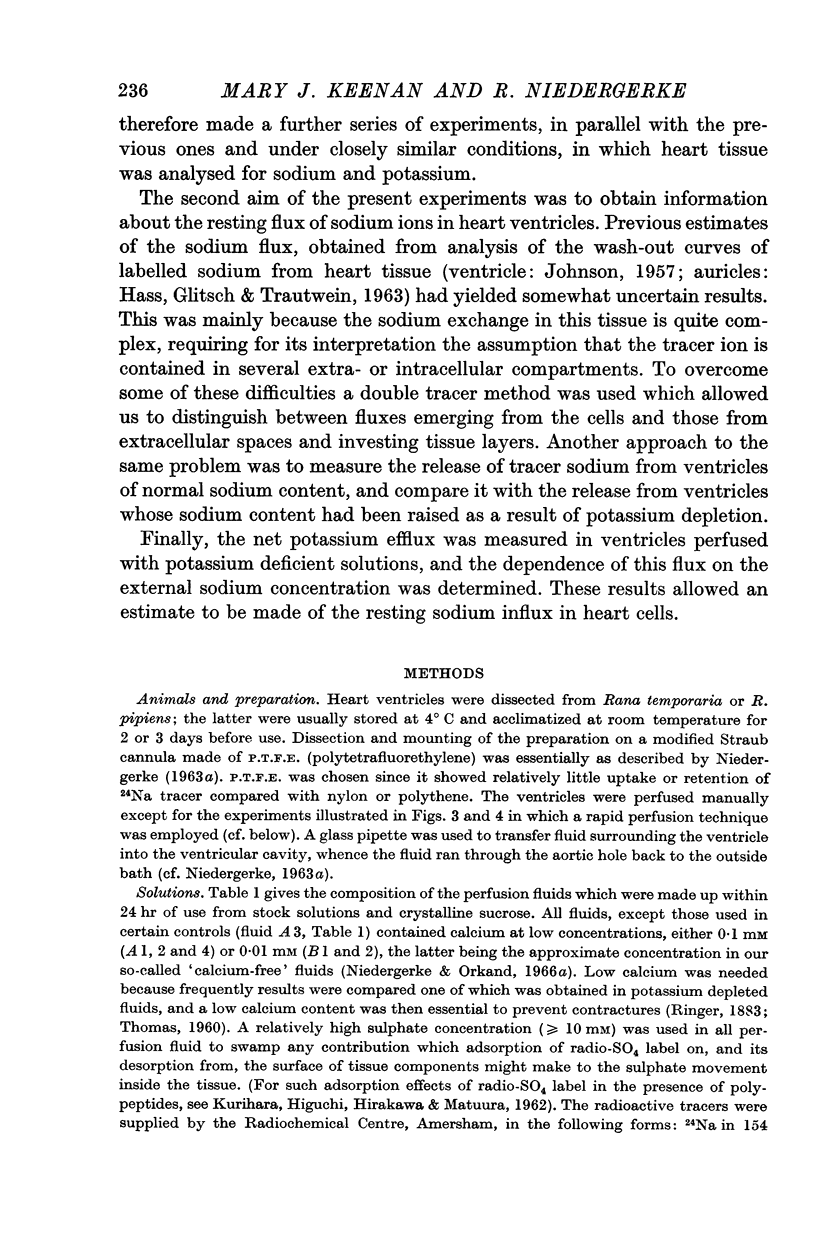
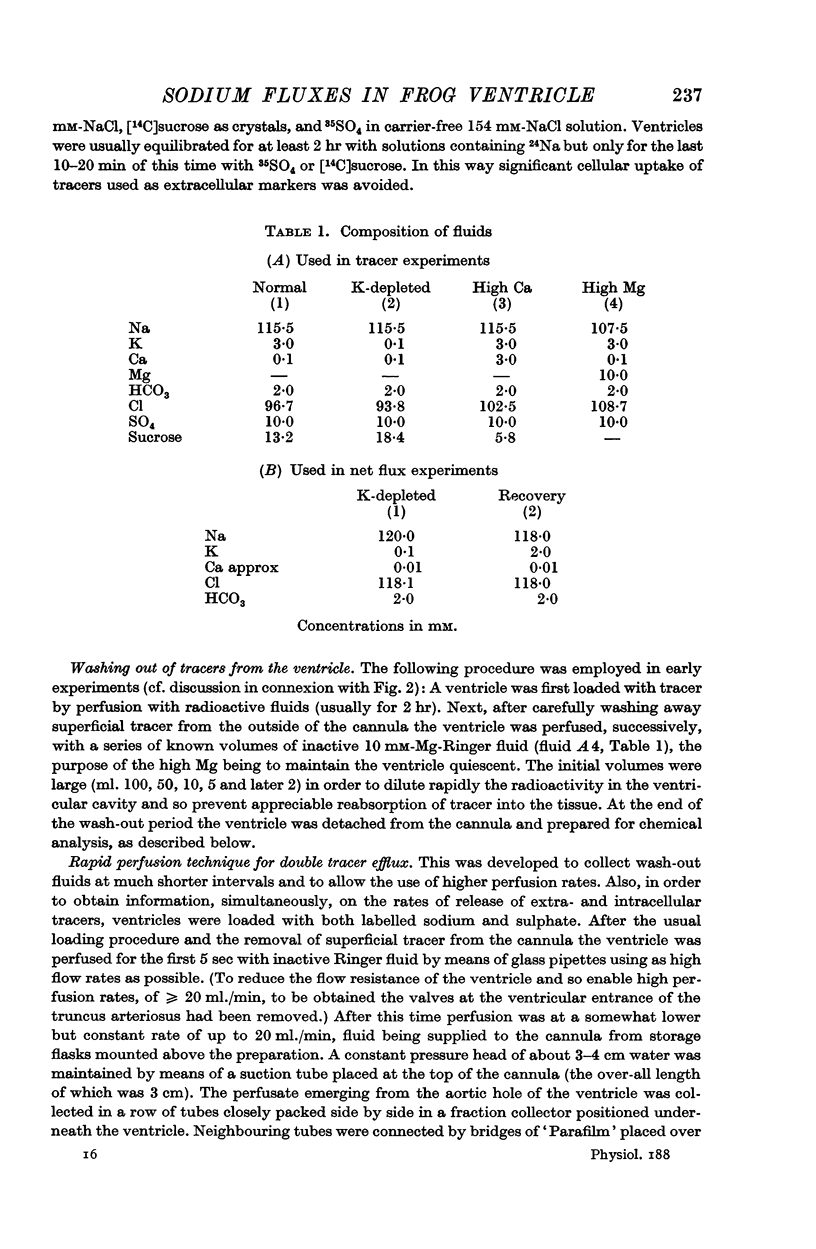

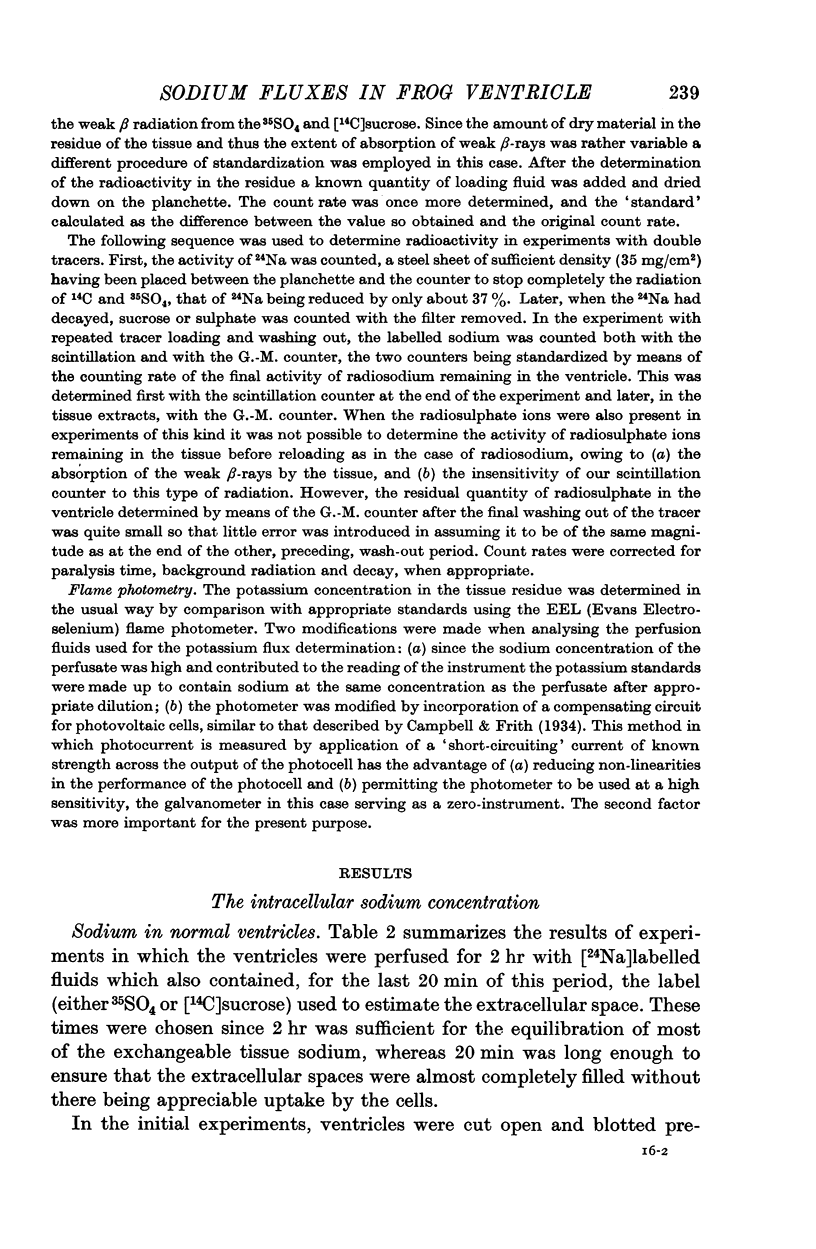
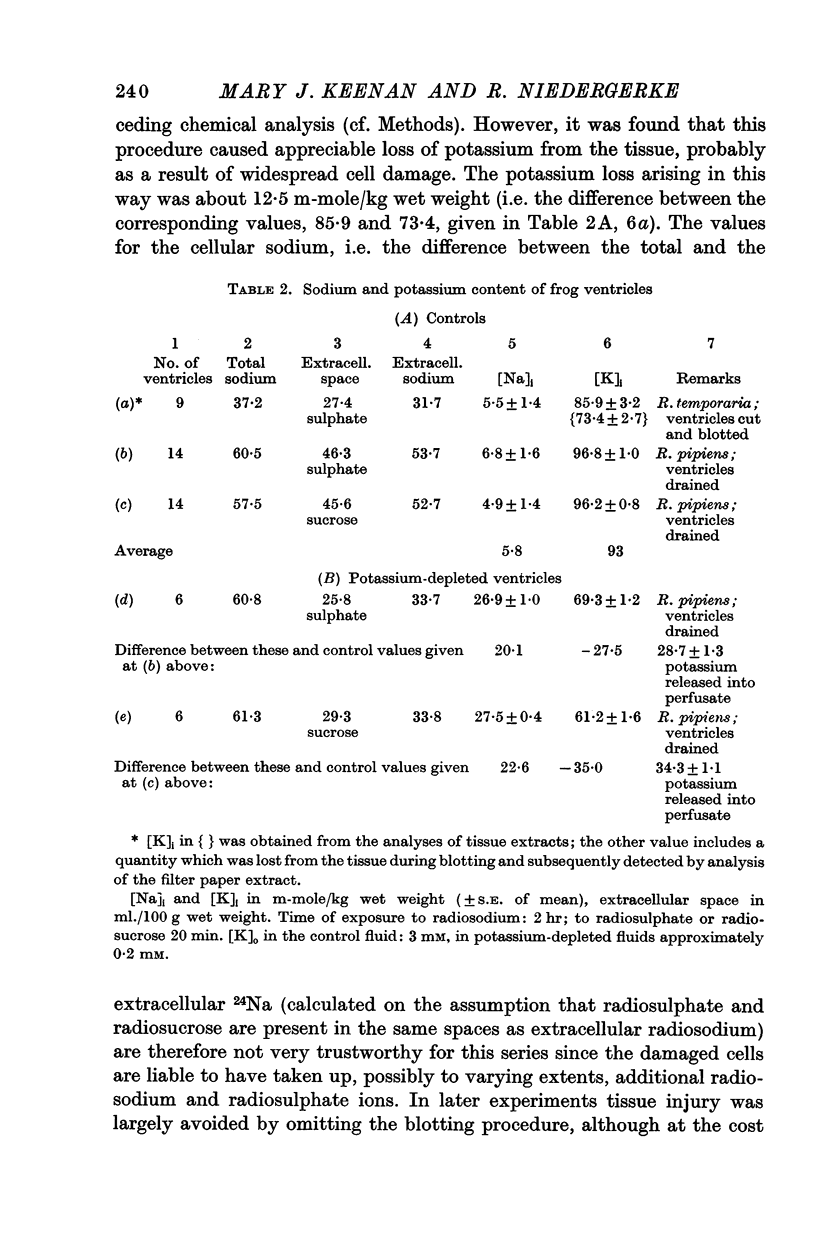

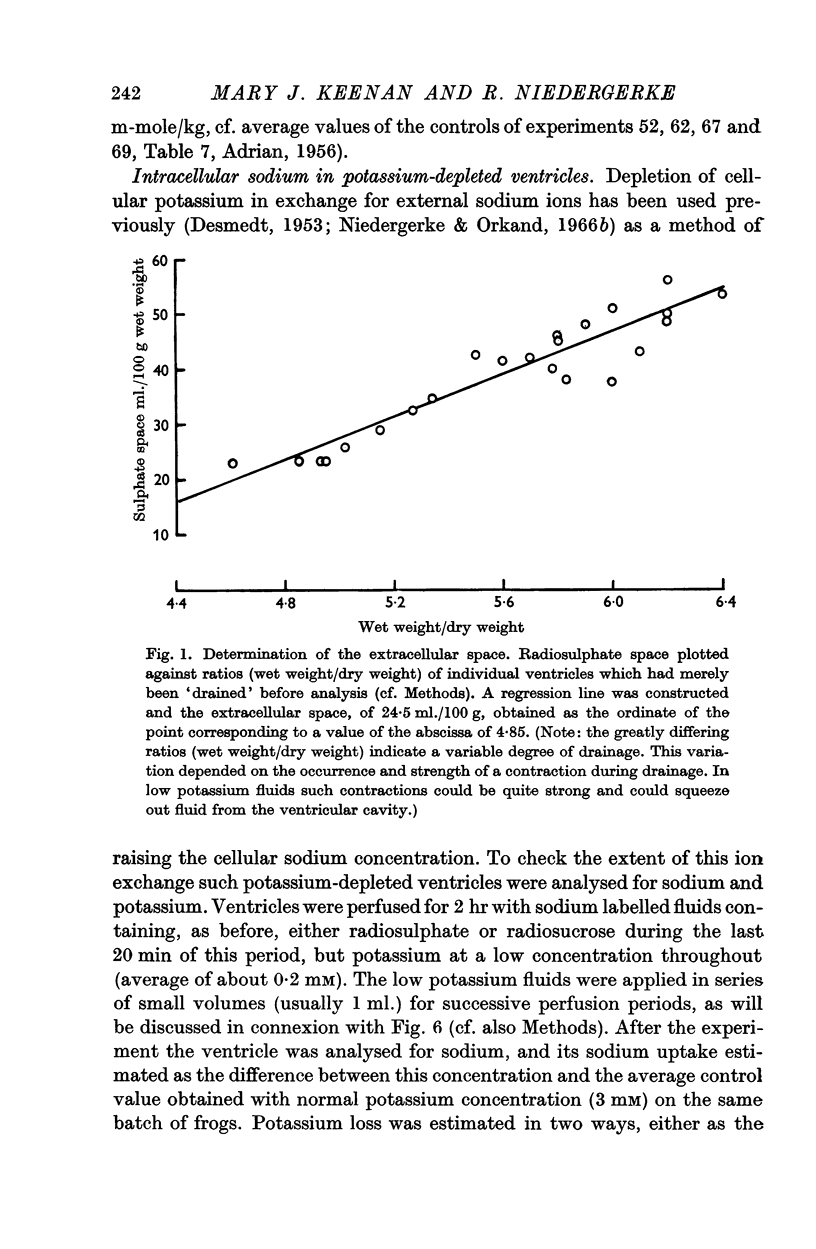
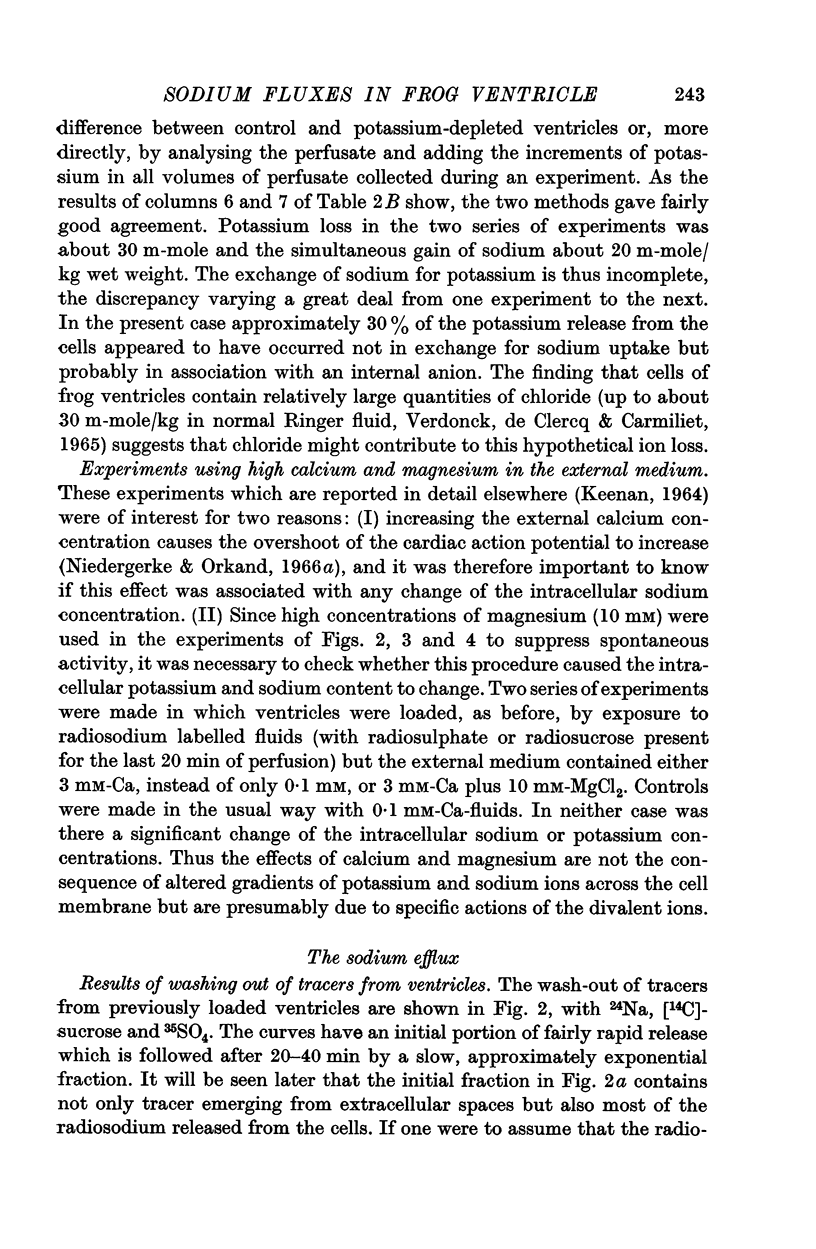
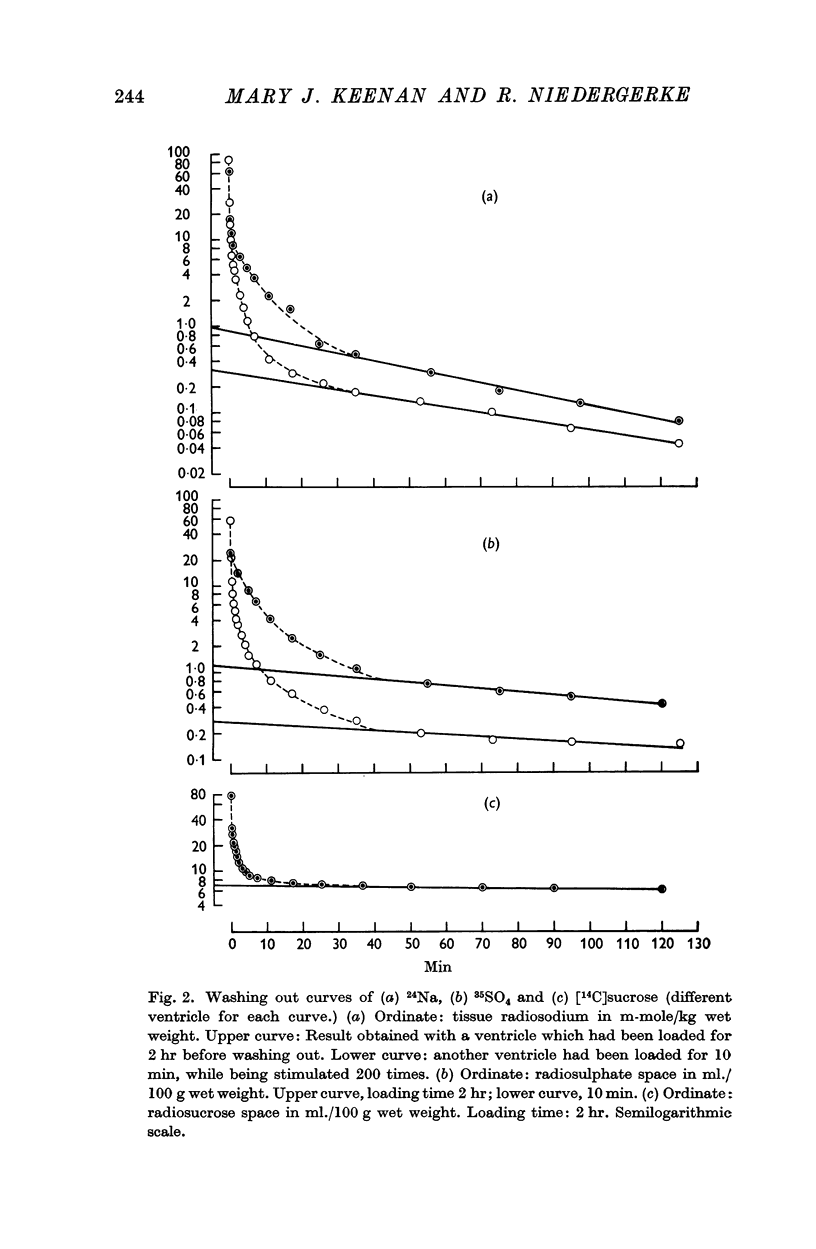
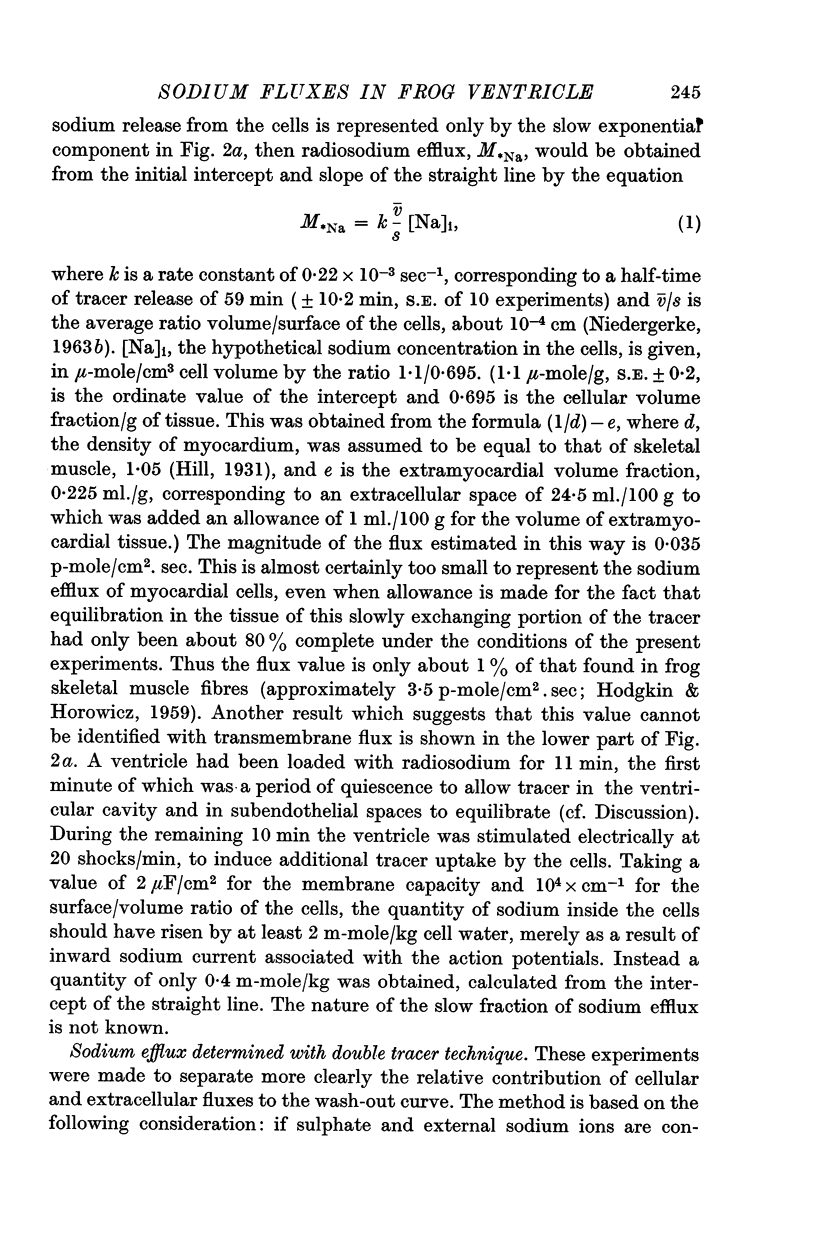
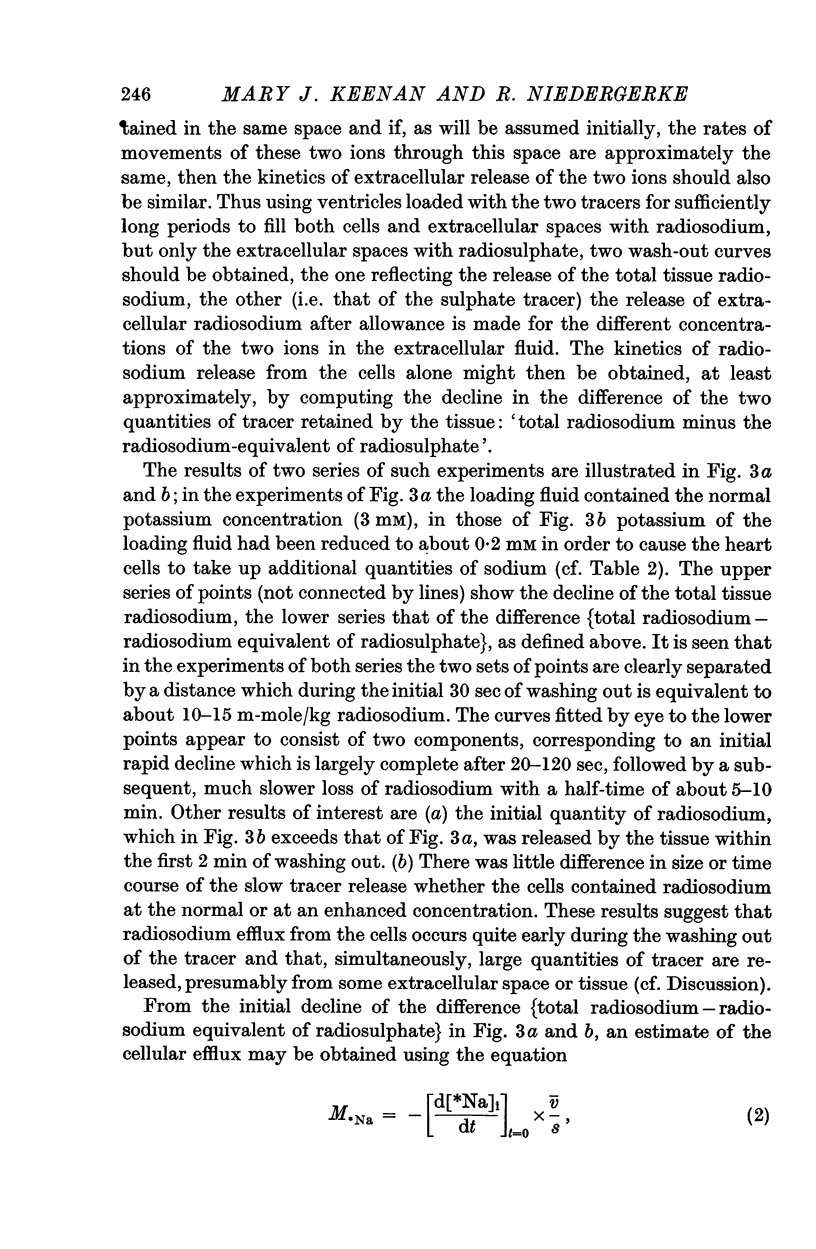
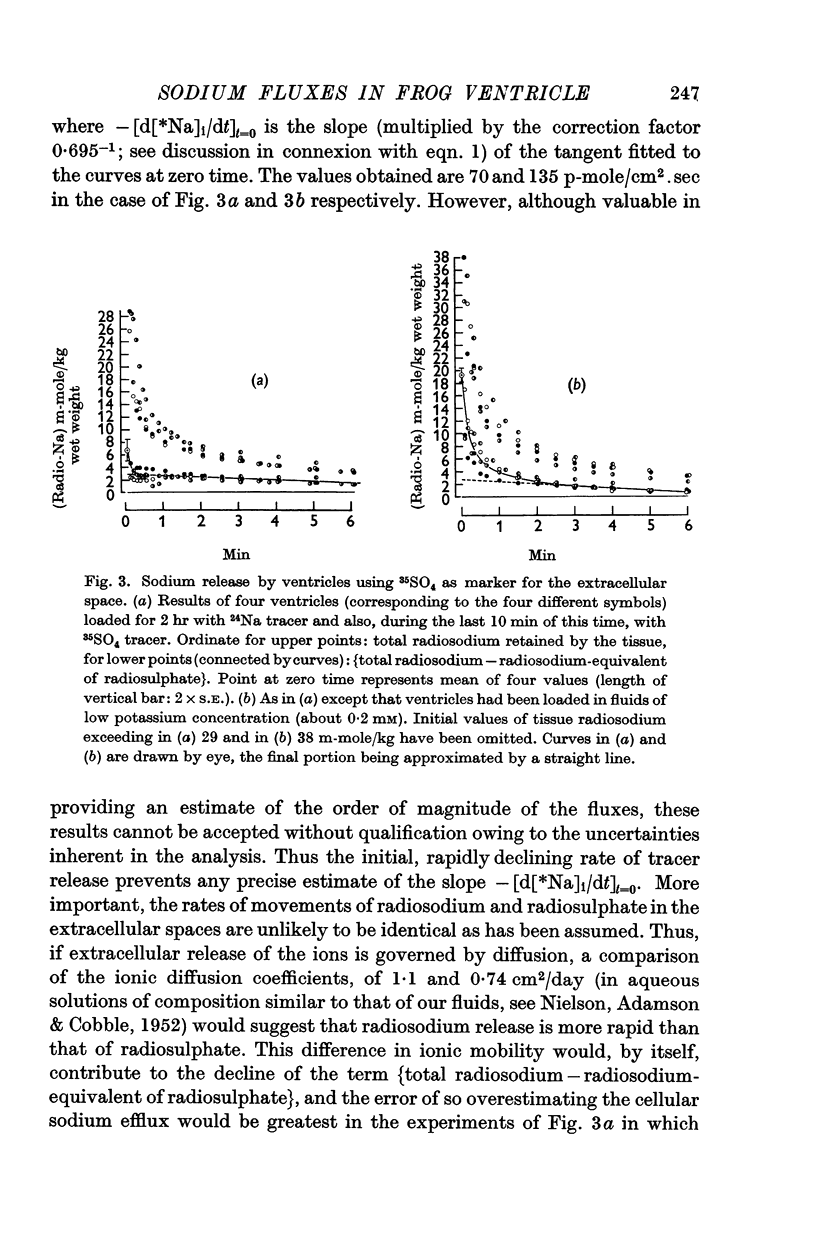
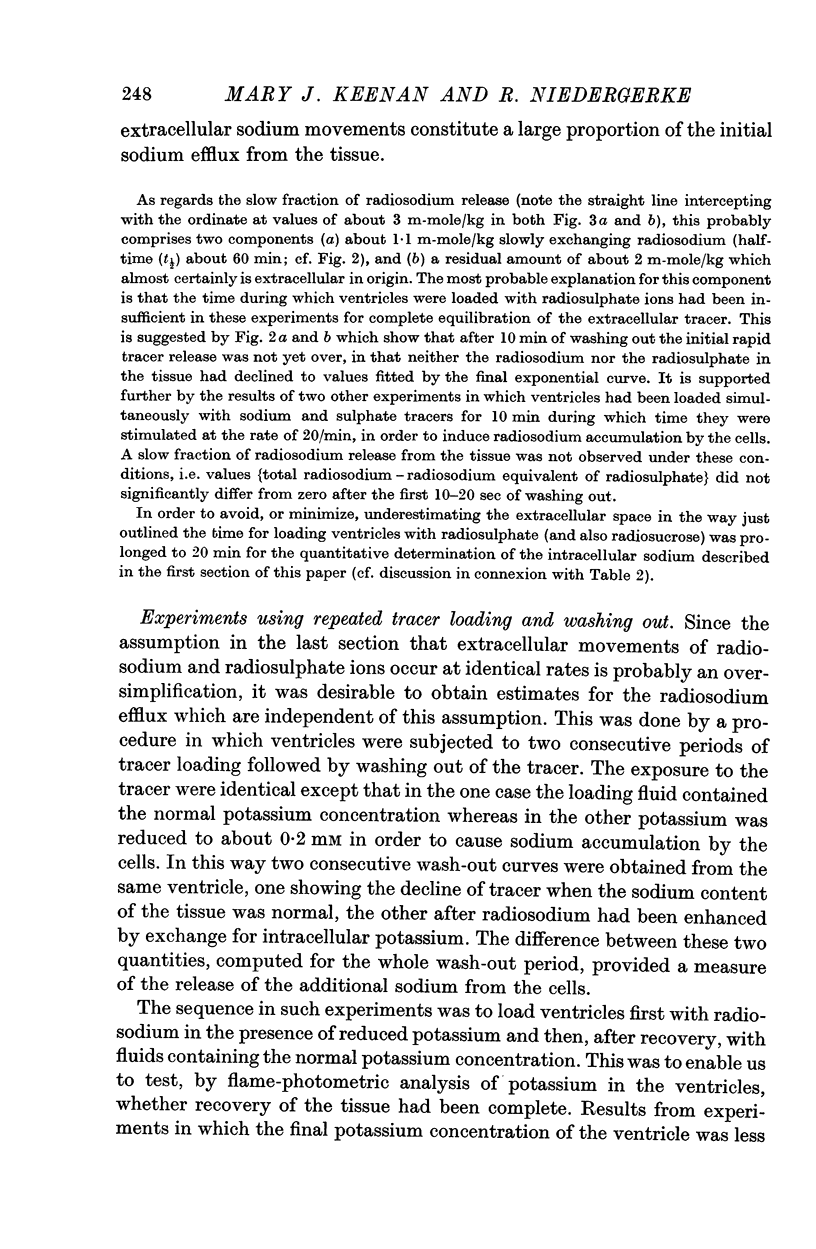
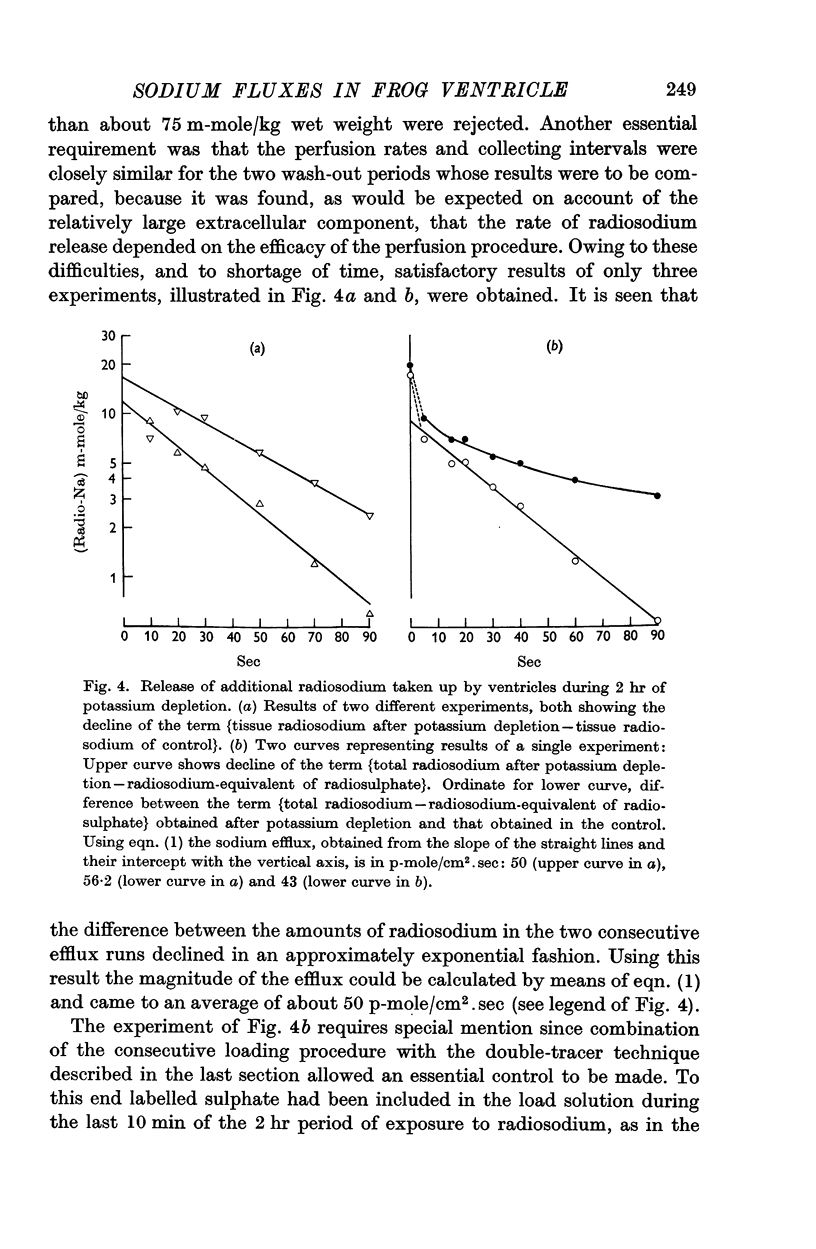
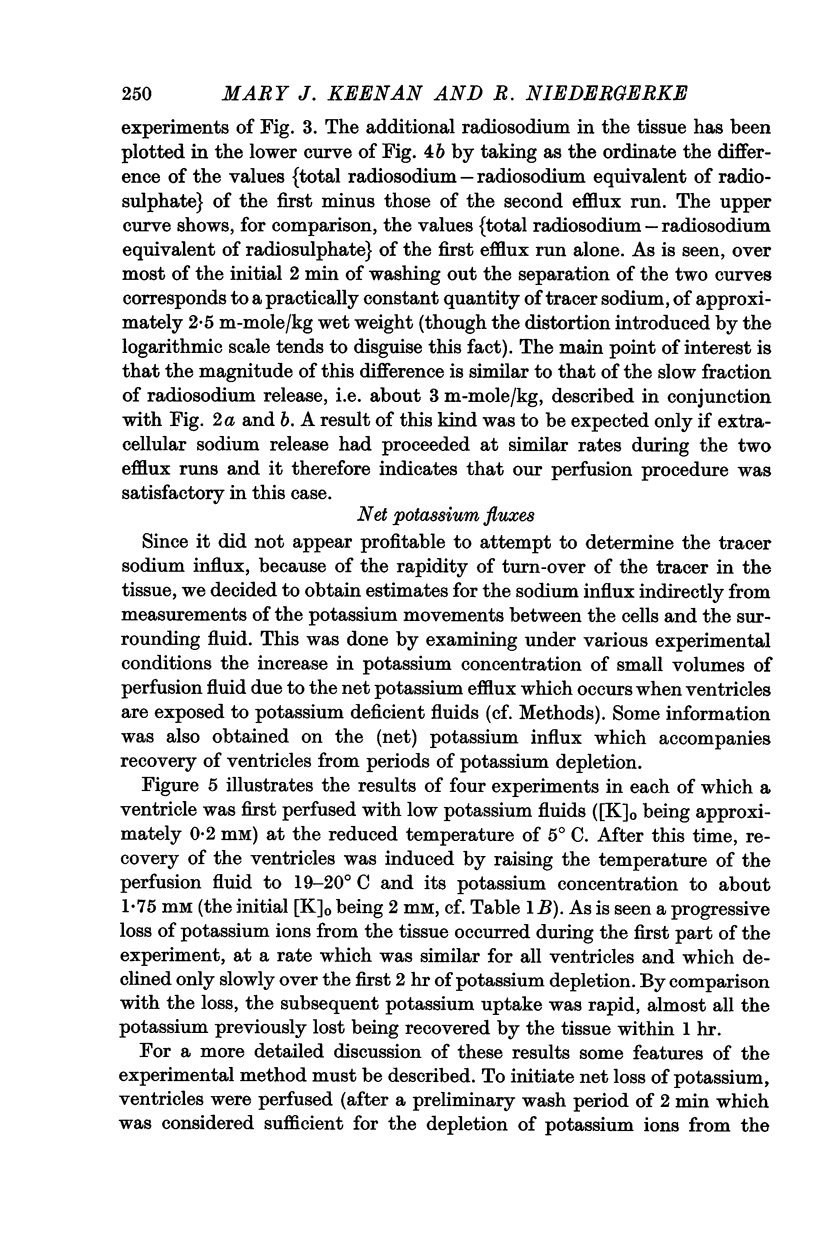
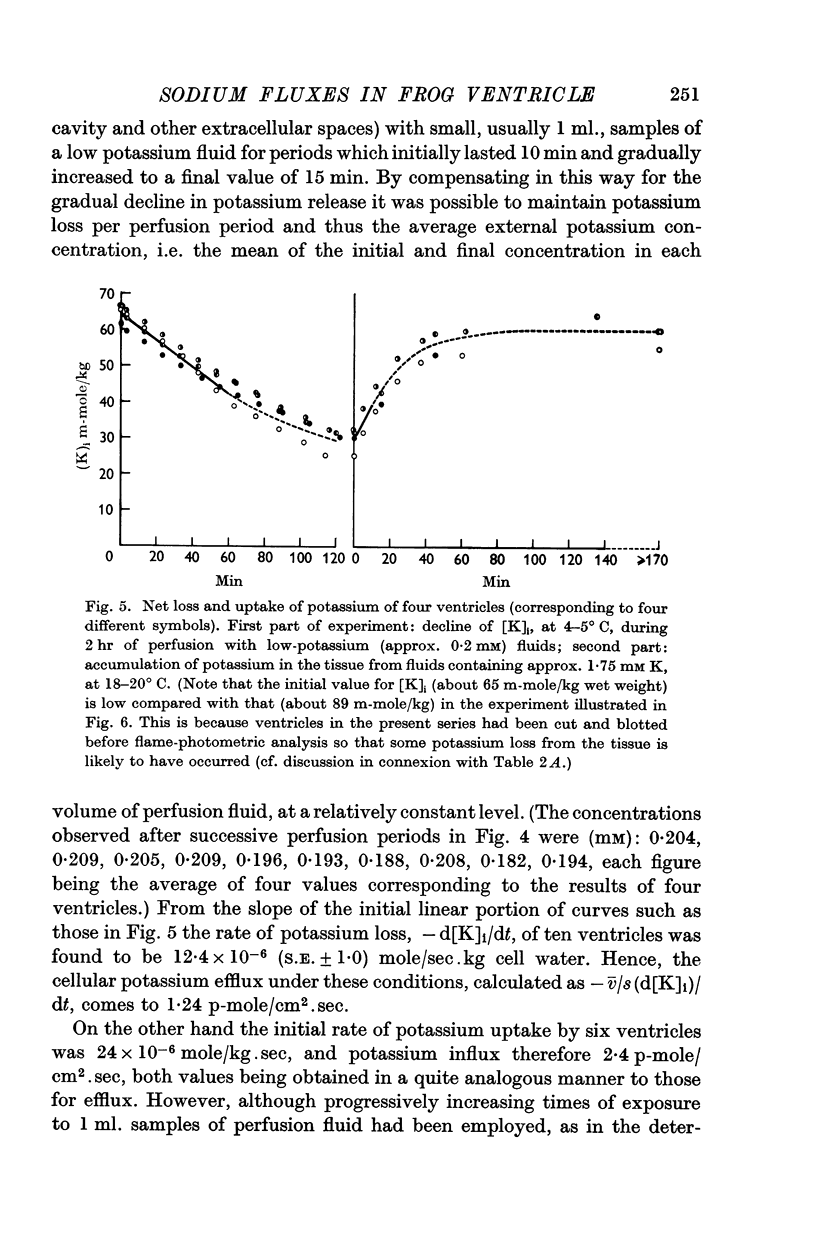
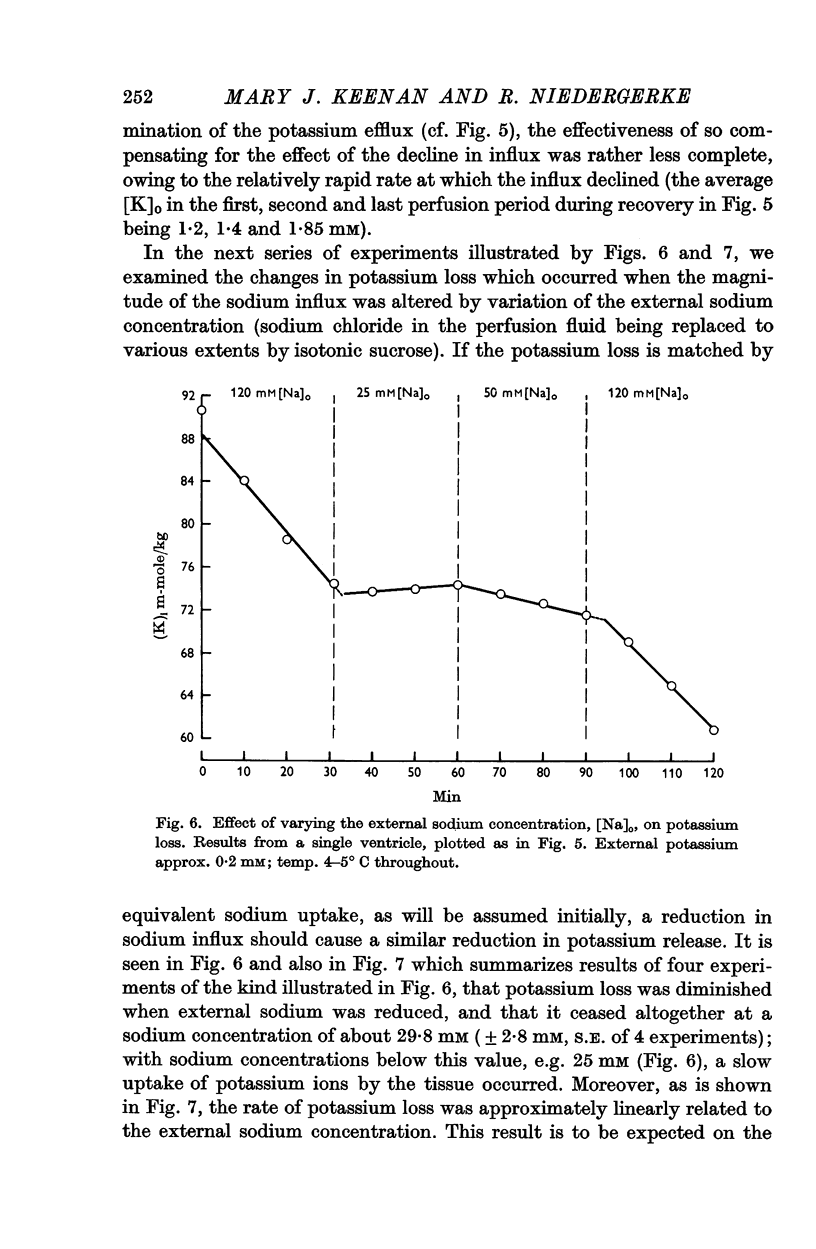
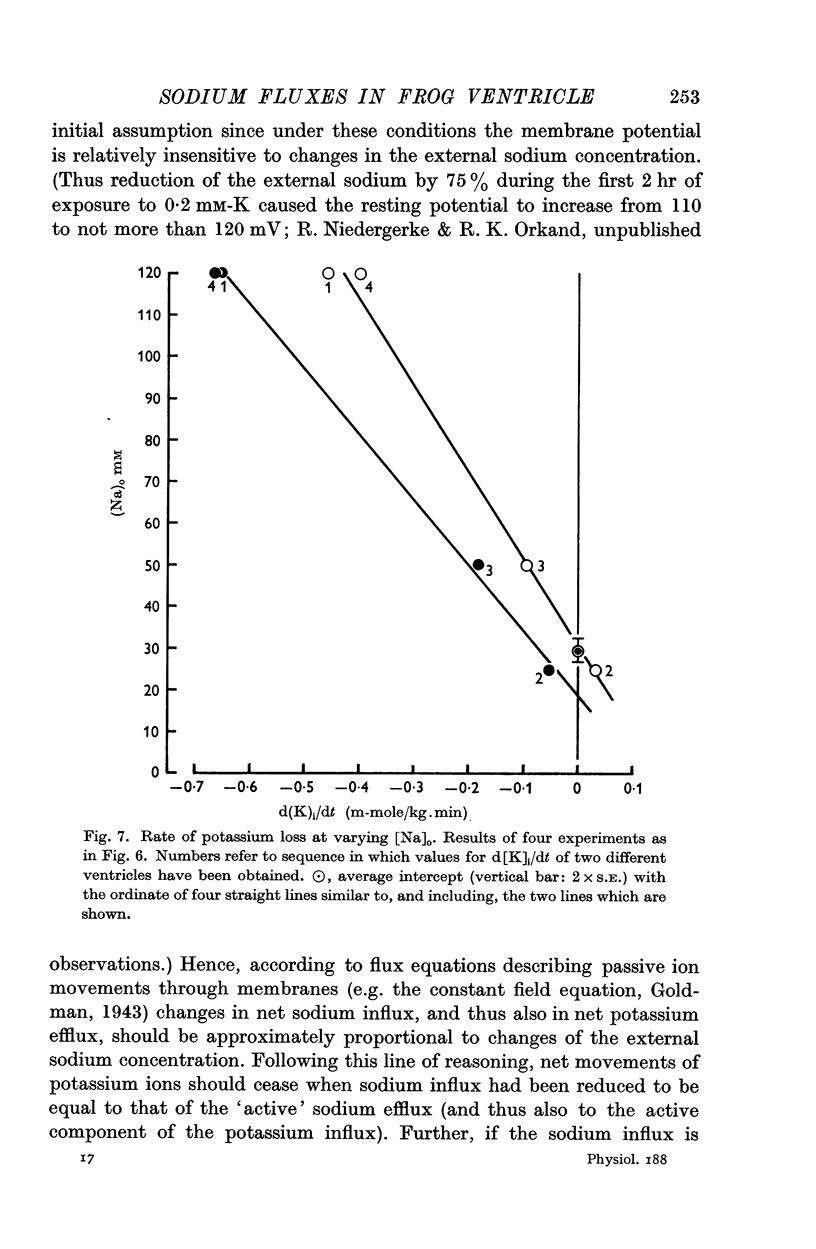
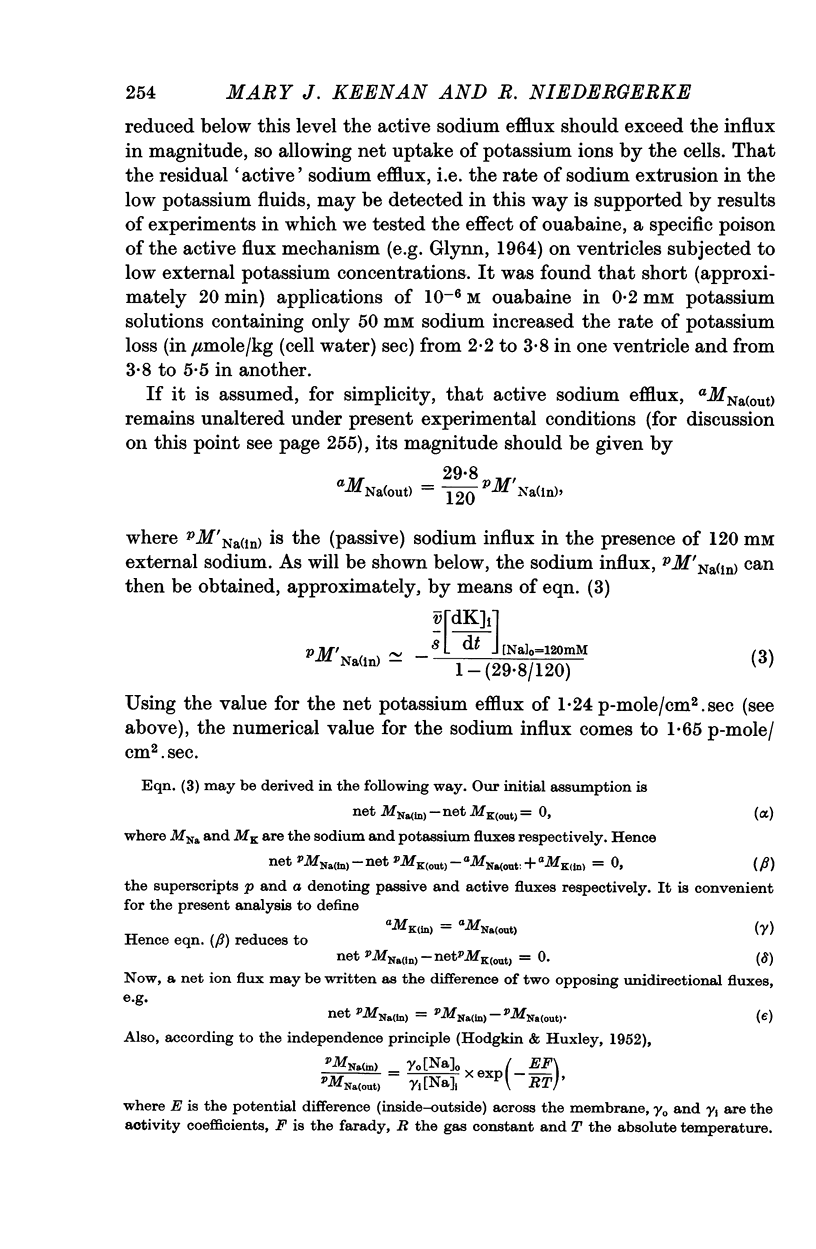
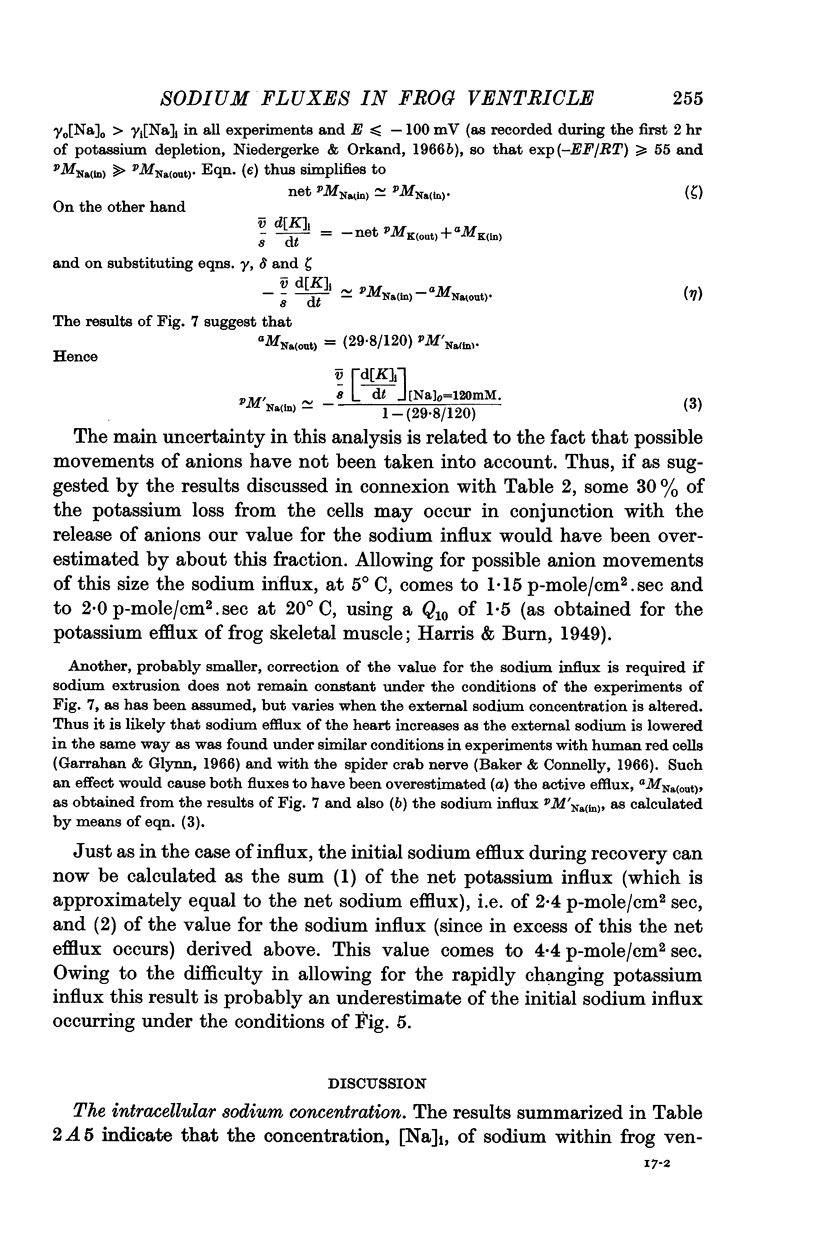
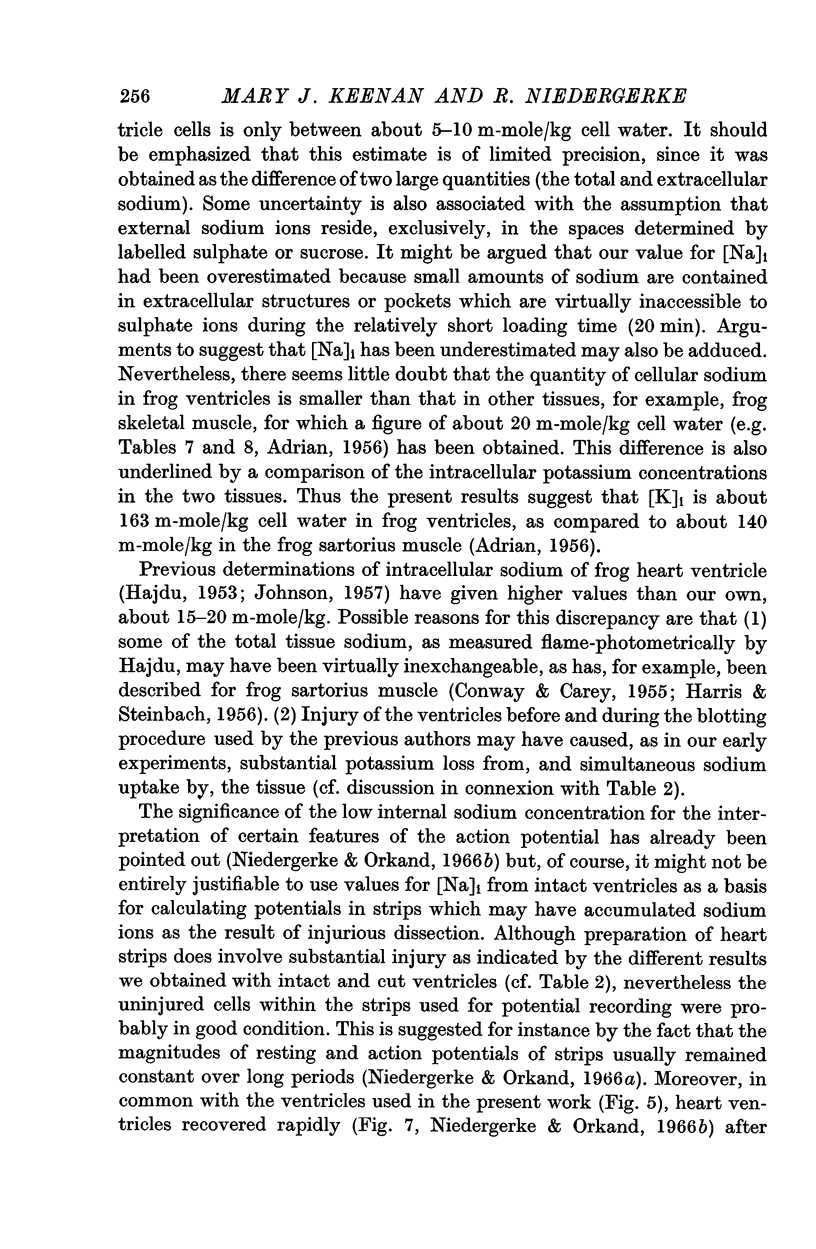
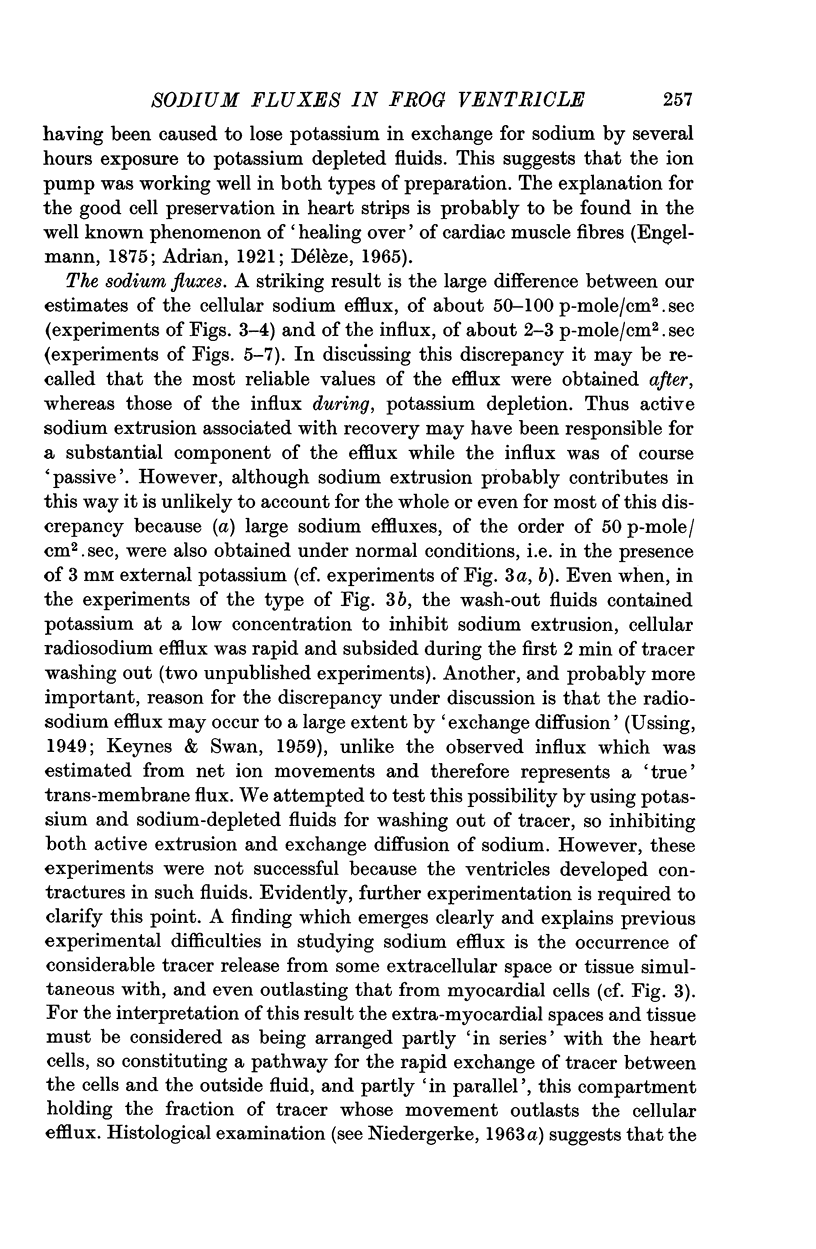
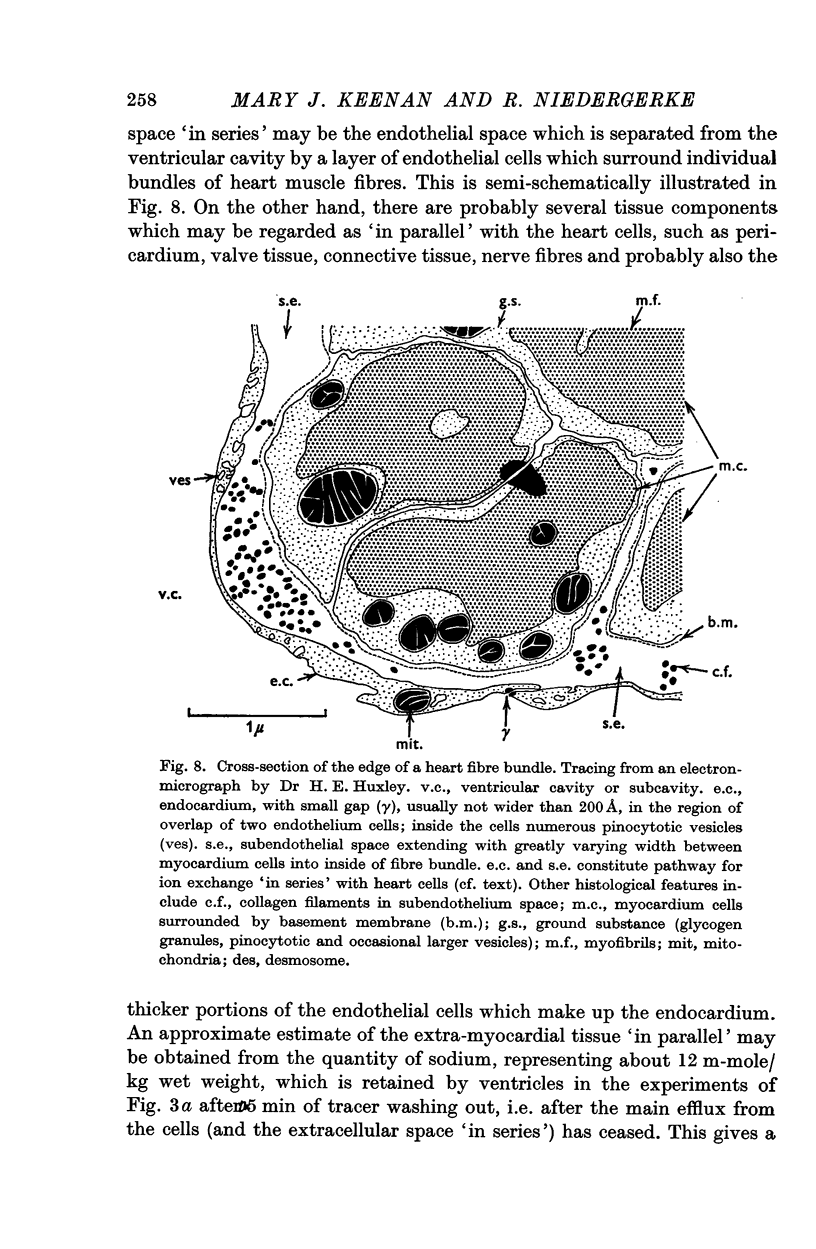
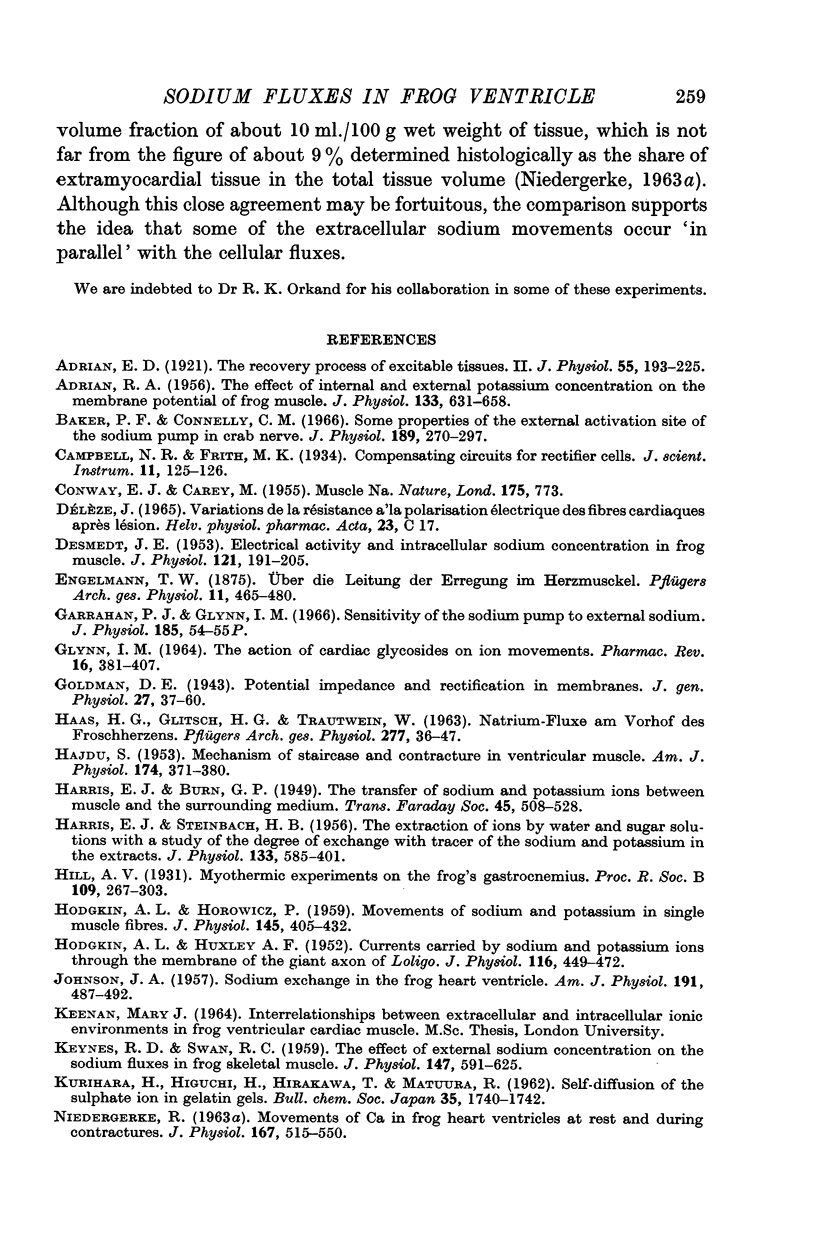
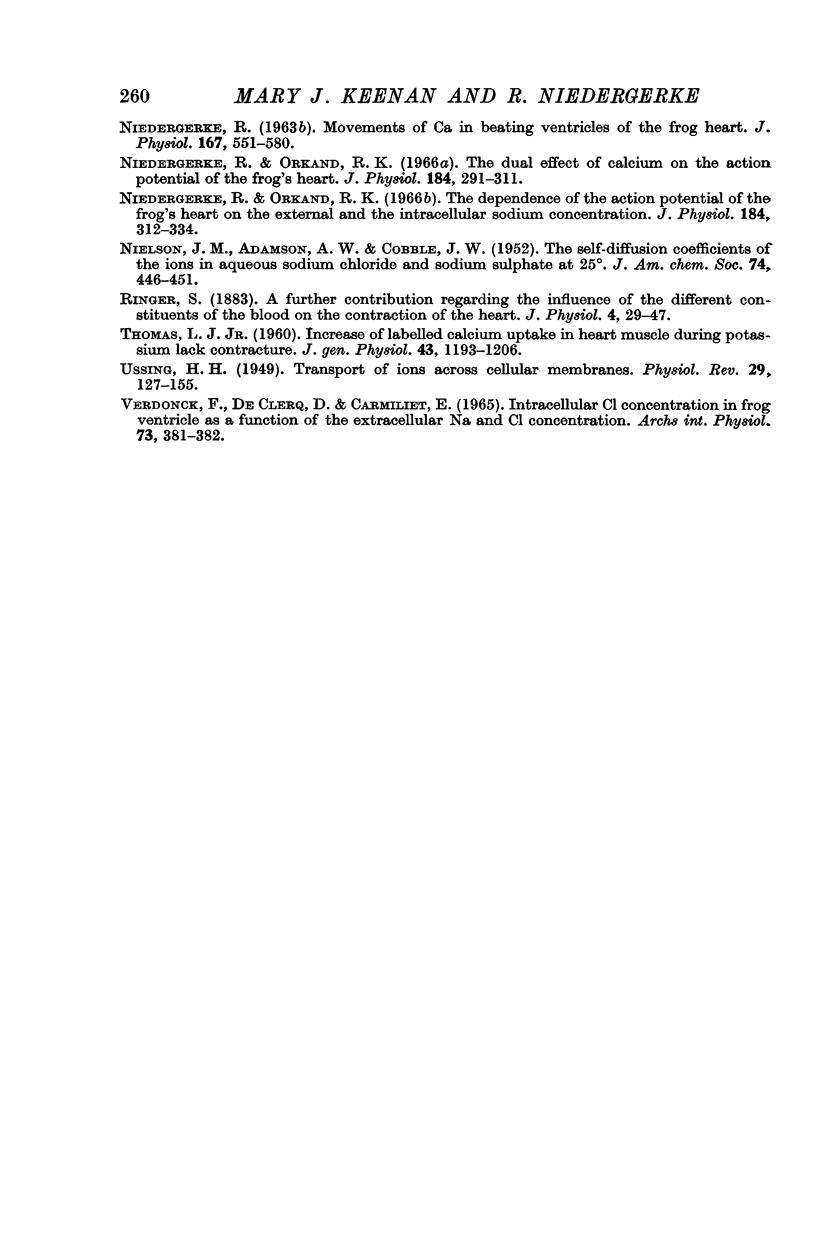
Selected References
These references are in PubMed. This may not be the complete list of references from this article.
- ADRIAN R. H. The effect of internal and external potassium concentration on the membrane potential of frog muscle. J Physiol. 1956 Sep 27;133(3):631–658. doi: 10.1113/jphysiol.1956.sp005615. [DOI] [PMC free article] [PubMed] [Google Scholar]
- Adrian E. D. The recovery process of excitable tissues: Part II. J Physiol. 1921 Aug 3;55(3-4):193–225. doi: 10.1113/jphysiol.1921.sp001963. [DOI] [PMC free article] [PubMed] [Google Scholar]
- Baker P. F., Connelly C. M. Some properties of the external activation site of the sodium pump in crab nerve. J Physiol. 1966 Jul;185(2):270–297. doi: 10.1113/jphysiol.1966.sp007987. [DOI] [PMC free article] [PubMed] [Google Scholar]
- CONWAY E. J., CAREY M. J. Muscle sodium. Nature. 1955 Apr 30;175(4461):773–773. doi: 10.1038/175773a0. [DOI] [PubMed] [Google Scholar]
- DESMEDT J. E. Electrical activity and intracellular sodium concentration in frog muscle. J Physiol. 1953 Jul;121(1):191–205. doi: 10.1113/jphysiol.1953.sp004940. [DOI] [PMC free article] [PubMed] [Google Scholar]
- GLYNN I. M. THE ACTION OF CARDIAC GLYCOSIDES ON ION MOVEMENTS. Pharmacol Rev. 1964 Dec;16:381–407. [PubMed] [Google Scholar]
- HAAS H. G., GLITSCH H. G., TRAUTWEIN W. [Sodium exchange in the atrium of the frog heart]. Pflugers Arch Gesamte Physiol Menschen Tiere. 1963;277:36–47. [PubMed] [Google Scholar]
- HAJDU S. Mechanism of staircase and contracture in ventricular muscle. Am J Physiol. 1953 Sep;174(3):371–380. doi: 10.1152/ajplegacy.1953.174.3.371. [DOI] [PubMed] [Google Scholar]
- HARRIS E. J., STEINBACH H. B. The extraction of ions from muscle by water and sugar solutions with a study of the degree of exchange with tracer of the sodium and potassium in the extracts. J Physiol. 1956 Aug 28;133(2):385–401. doi: 10.1113/jphysiol.1956.sp005594. [DOI] [PMC free article] [PubMed] [Google Scholar]
- HODGKIN A. L., HOROWICZ P. Movements of Na and K in single muscle fibres. J Physiol. 1959 Mar 3;145(2):405–432. doi: 10.1113/jphysiol.1959.sp006150. [DOI] [PMC free article] [PubMed] [Google Scholar]
- HODGKIN A. L., HUXLEY A. F. Currents carried by sodium and potassium ions through the membrane of the giant axon of Loligo. J Physiol. 1952 Apr;116(4):449–472. doi: 10.1113/jphysiol.1952.sp004717. [DOI] [PMC free article] [PubMed] [Google Scholar]
- JOHNSON J. A. Sodium exchange in the frog heart ventricle. Am J Physiol. 1957 Dec;191(3):487–492. doi: 10.1152/ajplegacy.1957.191.3.487. [DOI] [PubMed] [Google Scholar]
- KEYNES R. D., SWAN R. C. The effect of external sodium concentration on the sodium fluxes in frog skeletal muscle. J Physiol. 1959 Oct;147:591–625. doi: 10.1113/jphysiol.1959.sp006264. [DOI] [PMC free article] [PubMed] [Google Scholar]
- NIEDERGERKE R. MOVEMENTS OF CA IN FROG HEART VENTRICLES AT REST AND DURING CONTRACTURES. J Physiol. 1963 Jul;167:515–550. doi: 10.1113/jphysiol.1963.sp007166. [DOI] [PMC free article] [PubMed] [Google Scholar]
- NIEDERGERKE R. Movements of Ca in beating ventricles of the frog heart. J Physiol. 1963 Jul;167:551–580. doi: 10.1113/jphysiol.1963.sp007167. [DOI] [PMC free article] [PubMed] [Google Scholar]
- Niedergerke R., Orkand R. K. The dependence of the action potential of the frog's heart on the external and intracellular sodium concentration. J Physiol. 1966 May;184(2):312–334. doi: 10.1113/jphysiol.1966.sp007917. [DOI] [PMC free article] [PubMed] [Google Scholar]
- Niedergerke R., Orkand R. K. The dual effect of calcium on the action potential of the frog's heart. J Physiol. 1966 May;184(2):291–311. doi: 10.1113/jphysiol.1966.sp007916. [DOI] [PMC free article] [PubMed] [Google Scholar]
- Ringer S. A further Contribution regarding the influence of the different Constituents of the Blood on the Contraction of the Heart. J Physiol. 1883 Jan;4(1):29–42.3. doi: 10.1113/jphysiol.1883.sp000120. [DOI] [PMC free article] [PubMed] [Google Scholar]
- THOMAS L. J., Jr Increase of labeled calcium uptake in heart muscle during potassium lack contracture. J Gen Physiol. 1960 Jul;43:1193–1206. doi: 10.1085/jgp.43.6.1193. [DOI] [PMC free article] [PubMed] [Google Scholar]
- Verdonck F., De Clercq D., Carmeliet E. Intracellular Cl concentration in frog ventricle as a function of the extracellular Na and Cl concentration. Arch Int Physiol Biochim. 1965 Mar;73(2):381–382. [PubMed] [Google Scholar]


